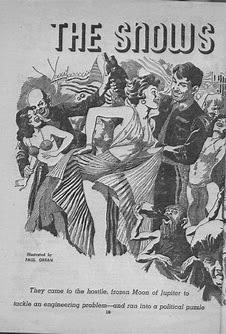Guards on Ganymede:
"...had the gangling, bulge-chested slenderness which was also characteristic of Martians - low gravity, low air pressure even inside the settlements -..." (IV, p.155)
That sounds right for human colonists of Mars. There is a book about designing sf aliens. Unfortunately, I cannot remember either the title or the author's name but maybe someone else will. There is a section on the Star Trek tribbles. The book posed the question how to design native (not colonial) Martians and suggested the following line of argument:
Then the book argued that that is a Terrestrial biped adapted to Mars, not an organism that has evolved on Mars. For the latter, we have to start again from scratch. But Anderson, of course, was describing colonials.

6 comments:
Kaor, Paul!
I have my doubts humans colonizing Mars would change much, not when evolution takes so long to be significant. Also, the real talent of human beings is making their environments serve their needs and wishes. Thus, on Mars, the slow and gradual terraforming of the Red Planet into a Blue Mars would lessen the likelihood of really significant evolutionary changes in humans living there.
Ad astra! Sean
Yup, agree with Sean. Why have low air pressure inside pressurized environments?
Kaor, Mr. Stirling!
Thanks! But for a long time colonists on Mars will have to live inside pressurized environments within domes.
Ad astra! Sean
Sean: yeah, and pressurized tunnels and the like.
If the O2 partial pressure is in the range humans live in commonly on earth (21 kPa down to maybe 15 kPa, I know Tibet or the Altiplano is lower, but lets confine it to the range people born & raised near sea level have no problem with) would it matter to human health if the partial pressure of inert gasses like nitrogen & argon is significantly less (or more)?
Keeping the Martian settlements at lower *total* pressure shouldn't require any adaptation.
Kaor, Mr. Stirling and Jim!
Mr. Stirling: With those sealed and pressurized tunnels being the links between both underground structures and surface domes on Mars.
Jim: I wouldn't know, but Robert Zubrin might well have discussed such questions in his massively detailed book THE CASE FOR MARS, which I read years ago.
Ad astra! Sean
Post a Comment